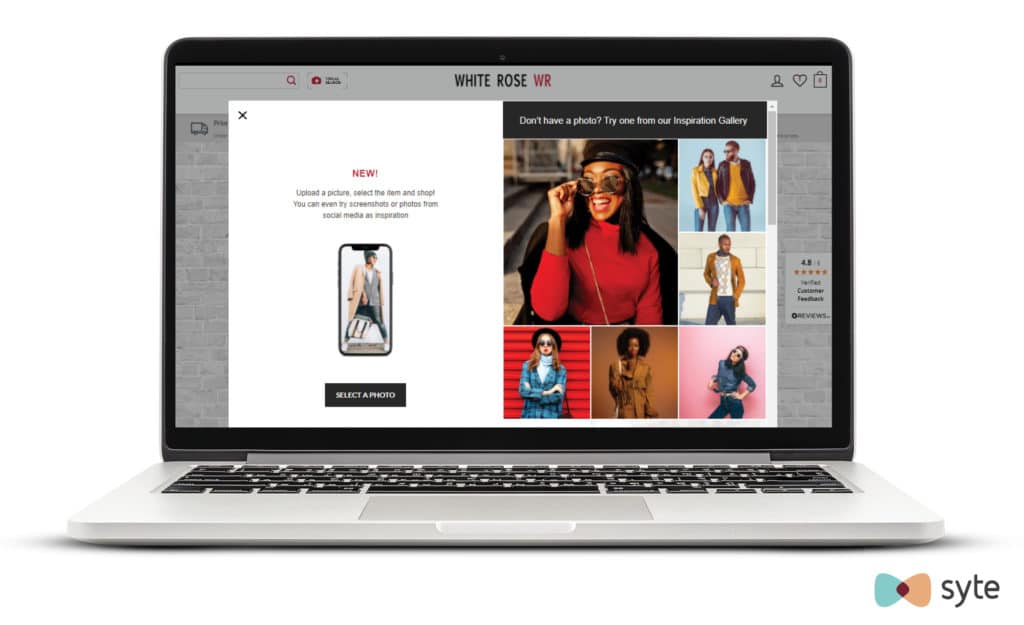Visual search is a technology that uses artificial intelligence (AI) to enable shoppers to search online using any type of image instead of text or keyword. This is extremely useful for people who don’t know exactly how to describe what they’re looking for or type the wrong search terms into the search bar. In cases like these, visual search helps to simplify the search process and enable goal-oriented shoppers to find the right products faster and easier.
Who Is Using Visual Search?
Pinterest, Google, and Amazon are some of the companies developing and offering this technology. Moreover, research shows that more and more consumers are using image search everyday. According to Bizrate Insights, while 53% of consumers said that they have not used the technology, they are willing and interested in trying it.
Here’s an example of visual search in action.
 Visual search feature on White Rose Recycled Fashion website
Visual search feature on White Rose Recycled Fashion website
How Does It Work?
Many factors dictate the success of a visual search engine, but it boils down to computer vision and image recognition. Computer vision is what enables machines such as mobile phones, tablets, and laptops to “see.” But simply seeing an object doesn’t mean it understands it. This is where the power of image recognition comes in.
Image recognition allows computers to identify, understand, and categorize specific objects within an image. To do this accurately, visual AI requires training. For example, researchers and engineers can feed an image search engine thousands of images of chairs in different styles, sizes, and colors. The AI engine processes and learns from every pixel in each image so it can refine and expand its understanding of different chairs over time. So, when users upload an image of a chair, a visual search engine can compare each pixel to every chair it’s ever seen, and automatically knows what it is and be able to surface all visually similar chairs in your product inventory.
Both computer vision and image recognition rely heavily on data and experience to improve performance over time.
What are the Benefits of Visual Search in eCommerce?
Visual search is a powerful tool for many eCommerce brands. It has a strong use case in highly visual verticals such as fashion, jewelry, and home décor, where images play a key role in influencing purchase decisions. Here are the top three benefits that visual search provides:
- It attracts, engages, and retains young consumers
Shoppers today visit social media not only to pass the time but also to consume visual content that inspires the next products they will buy. When they take a screenshot of a fashion or home décor inspiration from user-generated content, being able to upload it onto a visual search engine will immediately direct them to the most relevant products in your inventory. For a generation who are used to on-demand products and services, image search saves them time (they don’t have to think about the right keywords to search) and it offers quick and relevant results.
- Visual search delivers convenient and seamless product discovery
Finding the right product online is now a challenge for shoppers who have to contend with thousands of items and brands competing for their attention and wallet. An effective image search engine not only identifies and presents the most accurate products, it also keeps the customer journey going until shoppers zero in on the exact items that best match what they had in mind. For example, you can do this by offering the option to search for visually similar items on your product detail pages.
As consumers continue to gravitate toward personalized shopping journeys, visual search can help deliver contextual, relevant, and individualized customer experiences. For instance, if shoppers want to match a certain look, they can just upload a whole outfit inspiration to immediately find similar items. The same technology that drives image search also powers the recommendation engine on your site. Combined with the right tools, visual search supports the delivery of tailored shopping experiences that fit shoppers’ real-time browsing behavior and intent, increasing average order values and conversions.
A good place to continue learning about image search and its ecosystem is “The Definitive Guide to Visual Search.”